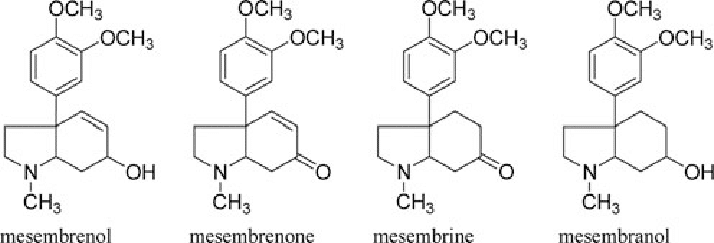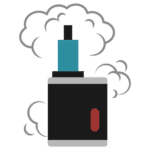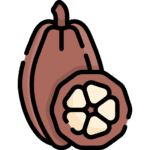Kanna - The Pharmacology of the Plant

Kanna is a "nickname" for the African succulent Sceletium tortuosum. S.tortuosum is botanically classified in the family Mesembryanthemaceae (Aizoaceae). The name "Sceletium" comes from the Latin word sceletus. It is due to the veins of its leaves which acquire skeletal structures when they are dehydrated.
S.tortuosum grows naturally in South Africa. It is widely known among the aboriginal tribes in those parts – especially in Namaqualand where it is often used for its healing and psychoactive properties. Locals also call it kougoed. The plant is traditionally chewed both for its psychoactive effects and for the fact that it appears to enhance their hunting abilities. Researchers of the plant claim that this name refers to the completion of the traditional preparation of the plant. After the plant material is harvested, it is dried and subjected to a fermentation process to increase its psychoactive effects.
Kanna – Alkaloids
The main alkaloids responsible for the psychoactive effects of S.tortuosum are mesembrine, mesembrenine or mesembrenone, mesembranol and mesembrenol. Mesembrin can be converted to Δ7-mesembrenone by fermentation. It is assumed that mesembrine and mesembrenine are the 2 alkaloids with the highest concentrations in plant tissues. Confirmed mesembrin is a potent serotonin reuptake inhibitor (SRI) while mesembrin is a dual SRI and PDE4 inhibitor. The raw plant contains varying concentrations of alkaloids/weight in ratios of 0.05 – 2.3%.
The plant's potential as an alternative supplement to promote well-being and treat a variety of psychological and psychiatric disorders such as depression and anxiety disorders has sparked intense interest in its pharmacological properties.
S.tortuosum is one of the few plants that appears to contain the alkaloids mesembrine and mesembrenine which can potentially be used to promote well-being and manage depression and anxiety disorders. These alkaloids appear to possess psychoactive, sedative, hypnotic and euphoric properties depending on the dosage. Due to these properties, they are used to treat anxiety, nervous tension, alcohol addiction and also to suppress hunger and thirst. In no case do they cause a strong altered perception of reality. It is clearly worth mentioning that according to clinical studies they do not create physical or psychological dependence! Their concentrations per S.tortuosum strain will vary according to the microclimate of the cultivation area and genetic factors.
Safety & Toxicology
The provision of Kanna in strong doses over a 2-week time horizon did not show the slightest toxicity even at doses for "elephants" (1800 times x the recommended dose of 25 mg of 2:1 extract). Administration of excessively high doses (200 times x recommended) and subsequent observation with hematological and histological tests also showed no toxic effects. Consequently, pharmacologically it is a completely safe herb when the simultaneous intake of pharmaceutical preparations and substances does not occur.
Administration of 8 or 25 mg of a 2:1 extract on a daily basis for 3 months - in healthy adults) was not associated with changes in cardiovascular parameters (blood pressure, heart rates, respiratory rates). No other side effects were observed.
Absorption of Alkaloids
Evaluation of the 4 main Kanna alkaloids by oral administration (oral or sublingual) and subsequent examination of intestinal membranes revealed the following: All 4 alkaloids penetrate membranes. Mesembrin exhibits the highest absorption rates followed by mesembranol. Mesembrenol and mesembrinin exhibit lower absorption rates. All elements are absorbed by both intestinal and oral membranes.
Higher absorption rates are observed in the intestine than in the oral cavity. These references apply to both the pure forms of the alkaloids and the extracts. Each method of reception achieves the absorption of the alkaloids. Traditionally the tribes of South Africa chew it.
Fermentation: Traditionally the plant is fermented for its psychoactive properties. Due to fermentation it ends up having lower concentrations of oxalic acid. In practical terms this means that fermentation promotes a stronger mental experience with much less chance of stomach upset. The natives of South Africa let the herb ferment for a week – they call the end product “Kougoed”.
Kanna – Beneficial Effects in Clinical Studies
Anxiety
In clinical studies in rats, at doses of 5mg/kg or 20mg/kg of a Kanna extract (the equivalent of 40-160mg for a 60kg human), administration of the extract was shown to reduce anxiety and moderate the rise in corticosterone. The lower dose appeared to be slightly more effective than the higher dose for these parameters. The higher dose appeared to be better at preventing abnormalities related to the immune system as a result of stress.
According to a small human study taking an extract (2:1 extract at a dose of 25 mg) before starting a PLT exercise (Perceptual-load-task: assesses reaction time and can put the subject in a state of anxiety) showed the following : While supplementation failed to improve performance, it did reduce amygdala reactivity in the test. Consequently it succeeded in reducing the state of stress in the study subjects.
As an anxious state we define the feeling of anxiety in response to stressful situations – in this case the brain area known as the amygdala shows activity higher than normal. This state of anxiety can reduce cognitive performance during stressful situations – not intrinsically related to chronic stress. Practically taking Kanna could be helpful during intense stressful situations.
Depression
In animal studies in rats, taking the herb appears to have antidepressant properties. Taking the equivalent of 8-25 mg of a 2:1 extract for humans had distinct "elevating" effects. More studies are needed to draw clear conclusions.
Learning (Nootropic)
In a study of 16 healthy volunteers aged 45-65 years, taking 25 mg of a 2:1 extract containing 0.4 % of total alkaloids (mesembrine, mesembrenol, mesembranol and mesembrenone) was successful in improving executive functions and cognitive flexibility .
*Extract 2:1 = Extract equal to twice the amount of raw herb. In the case of Kanna, the 25 mg of extract used for the clinical studies was equivalent to 50 mg of raw fermented Kanna.
Interactions & Contraindications
S.tortuosum can cause drowsiness. Taking it together with relaxing and hypnotic drugs can cause excessive drowsiness.
S.tortuosum is considered an SRI (serotonin reuptake inhibitor). It should not be combined with antidepressant drugs or medicinal monoamine oxidase (MAO) inhibitors. It is recommended to avoid the use of herbs that appear to act on serotonin receptors (eg, St. John's wort) or that appear to exhibit reversible inhibition of monoamine oxidase (RIMA) (eg, Syrian Rue, B.caapi).
There are no studies on the safe use of the plant during pregnancy or breastfeeding. So women experiencing these wonderful stages should avoid.
Kanna – Immunity & Addiction Potential
S.tortuosum is a plant that exhibits so-called “reverse immunity” – similar to that exhibited by serotonergic antidepressants or herbs such as kava kava. Practically this means that for the effects to become more intense and more therapeutic, the use of the plant should take the plant regularly. This method is also called “priming” – it usually requires daily use over a period of 1 week for the effects to become more pronounced. After a week of regular use, continuing to take the plant at the same doses does not cause an increase or decrease in its psychoactive effects.
Psychological dependence on Kanna is a possibility, but it is much, much less intense than the use of stimulants or antidepressants. Normally stopping taking the herb does not show withdrawal symptoms. Some long-term users report mild withdrawal symptoms of low intensity.
Sources
https://www.webmd.com/vitamins/ai/ingredientmono-1259/sceletium
https://examine.com/supplements/sceletium-tortuosum/research/
https://psychonautwiki.org/wiki/Talk:Kanna#Chemistry
(The Importance of Sceletium tortuosum (L.) NE Brown and Its Viability as a Traditional African Medicinal Plant) https://www.intechopen.com/online-first/75402
Krstenansky JL. Mesembrine alkaloids: Review of their occurrence, chemistry, and pharmacology. J Ethnopharmacol. 2017 Jan 4;195:10-19. doi: 10.1016/j.jep.2016.12.004. Epub 2016 Dec 7. PMID: 27939420 https://pubmed.ncbi.nlm.nih.gov/27939420/
Gericke, N., & Van Wyk, B. (2001). In African Natural Health CC (Ed.), Pharmaceutical compositions containing mesembrine and related compounds (6,288,104 ed.)
https://www.ncbi.nlm.nih.gov/pmc/articles/PMC8124331/
Patnala, S., & Kanfer, I. (2009). Investigations of the phytochemical content of sceletiu tortuosum following the preparation of "kougoed" by fermentation of plant material. Journal of Ethnopharmacology, 121(1), 86
Rebecca Schell, Scripps College (2004). Sceletium tortuosum and Mesembrine: A Potential Alternative Treatment for Depression https://scholarship.claremont.edu/scripps_theses/375/
Murbach et al (2014). A toxicological safety assessment of a standardized extract of Sceletium tortuosum (Zembrin®) in rats https://pubmed.ncbi.nlm.nih.gov/25301237/
Makolo et al (2019). Mesembrine: The archetypal psycho-active Sceletium alkaloid https://pubmed.ncbi.nlm.nih.gov/31299396/
Manda VK et al (2017). Quantification of mesembrine and mesembrenone in mouse plasma using UHPLC-QToF-MS: Application to a pharmacokinetic study
https://pubmed.ncbi.nlm.nih.gov/27526669/
Manganyi MC, Bezuidenhout CC, Regnier T, Ateba CN. A Chewable Cure “Kanna”: Biological and Pharmaceutical Properties of Sceletium tortuosum. Molecules. 2021? 26(9):2557. https://doi.org/10.3390/molecules26092557g/10.3390/molecules26092557

 Ethos Herbals Blends
Ethos Herbals Blends Cannabis
Cannabis SmartShop
SmartShop VapeShop
VapeShop Medicinal Herbs
Medicinal Herbs Cacao & Tea
Cacao & Tea Aromatherapy
Aromatherapy Ethos Lifestyle
Ethos Lifestyle